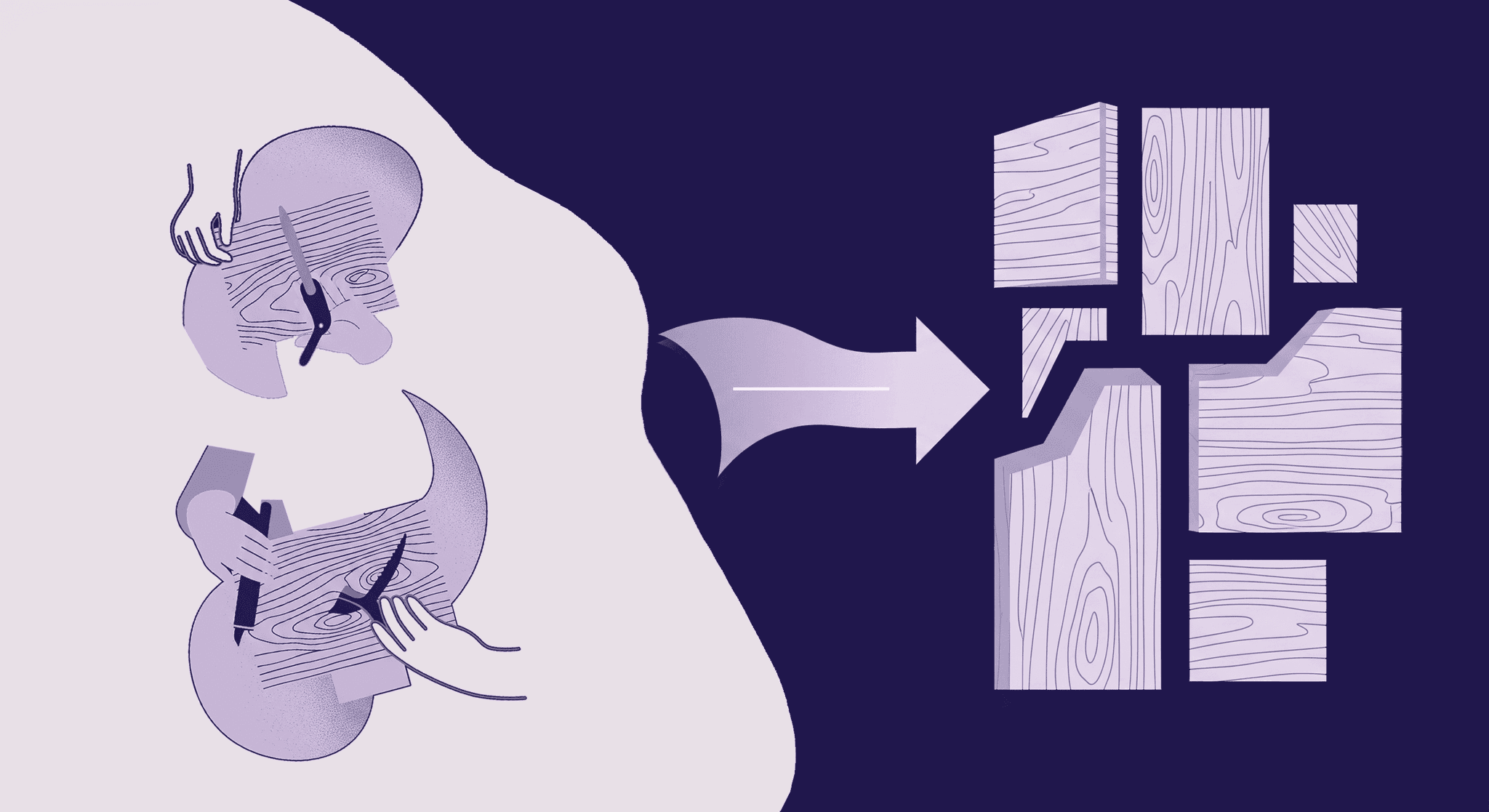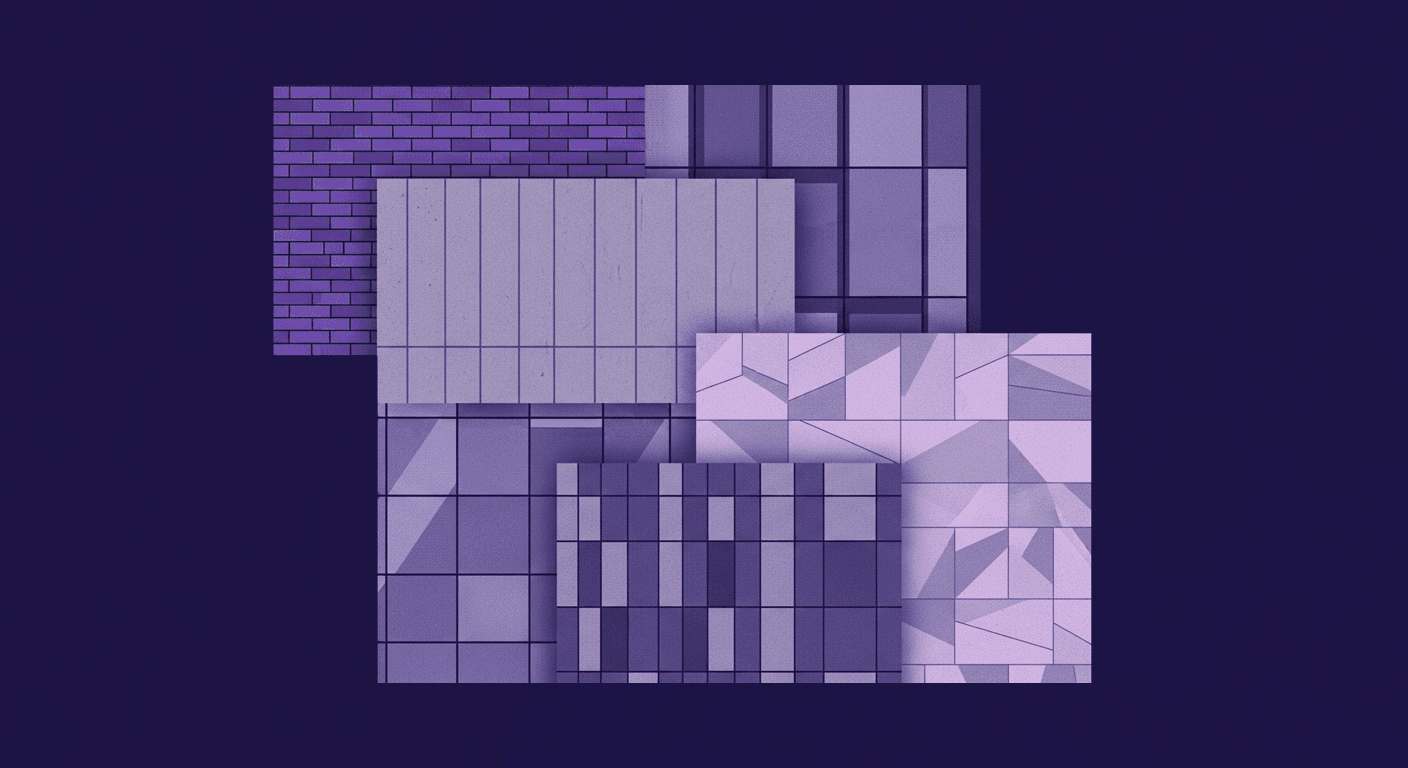Mastering Wood Veneer Textures: A Creative Guide to Techniques
By Max Calder | 17 July 2025 | 14 mins read
Table of contents
Table of Contents
You can spend hours tweaking lighting and shaders in your render, but sometimes, the wood surfaces just fall flat. They have the right color, but they lack the life and depth of the real thing. It’s a common frustration that last 10% that separates a good visualization from a photorealistic one. This guide unpacks the techniques that bridge that gap. We’re moving beyond simple grain matching to explore how the pros create compelling wood veneer textures from mastering classic cuts and matches to designing entirely new geometric and spliced patterns. It’s about giving you a complete toolkit to control the visual story of your surfaces. When you can design with texture intentionally, you're not just creating more convincing renders you're building a clearer blueprint for physical prototypes, ensuring your vision translates flawlessly from pixel to product.

Getting started: Your veneer toolkit and workspace
Before you can start creating those jaw-dropping surfaces, you need the right setup. Think of your workspace and tools not as an expense, but as an investment in precision. Getting this right from the start saves you headaches and material down the line. It’s the difference between a project that looks professional and one that screams “DIY mishap.”
What tools are best for creating wood veneer textures?
You don’t need a giant workshop, but you do need a few key items. Let’s skip the fluff and get right to what actually works.
- A proper veneer saw: Forget the utility knife. A veneer saw has a serrated, double-edged blade that cuts on the pull stroke. Why does that matter? It gives you a crisp, clean edge with zero tear-out, which is absolutely critical for invisible seams. One edge has more teeth per inch for fine work, the other has fewer for faster cuts. It’s a small tool that makes a huge difference.
- Self-healing cutting mat & steel straightedge: Your cuts are only as straight as your guide. A heavy, cork-backed steel straightedge won’t slip while you’re cutting. Paired with a large self-healing mat, you get a consistently clean and precise cut every single time. This duo is non-negotiable for geometric patterns.
- The right adhesive and applicator: You have two main choices here. Cold-press veneer glue is forgiving, giving you a longer working time to position your pieces. It requires even clamping pressure to set. Contact cement is faster but demands perfection once the two surfaces touch, there’s no repositioning. For complex patterns, cold-press glue is your friend. For applying it, a small foam roller ensures a thin, even coat without lumps that can show through the veneer.
- A clean, well-lit workspace: This sounds obvious, but it’s the most overlooked part of the process. You need excellent lighting to truly see the subtleties in the wood grain and match them effectively. A flat, clean workbench is also essential. Any dust, debris, or imperfections on your work surface can transfer to your glue or get pressed into the veneer, creating a permanent flaw.
Understanding how veneer cuts affect texture
Here’s where the real design work begins. The way a log is cut determines the grain pattern, and that pattern is the foundation of your wood veneer texture. Choosing the right cut is just as important as choosing the right wood species. It’s the first and most impactful decision you’ll make.
- Rotary cut: Imagine a log being turned on a giant lathe while a blade “unpeels” it like a paper towel roll. This produces a wide, often wild and unpredictable grain pattern. It’s efficient and covers large areas, but the look can be overpowering. Use it when you want a bold, dramatic effect, but be cautious, as it can sometimes look less refined than other cuts.
- Plain-sliced (or flat-cut): This is the most common cut and likely what you picture when you think of wood grain. The log is sliced lengthwise, creating the iconic cathedral or flame-like pattern in the center with straighter grain on the sides. It's a versatile, classic look that provides a beautiful, organic feel perfect for most applications.
- Quarter-sliced: For this cut, the log is first cut into quarters, and then each quarter is sliced at a right angle to the growth rings. The result? A remarkably straight, linear grain pattern. It provides a clean, modern, and architectural feel. If you want a surface that feels uniform and sophisticated, quarter-sawn is the way to go. It minimizes the cathedraling effect and gives you a consistent visual rhythm, which is fantastic for slip-matching on large panels.
Understanding these cuts moves you from just applying a material to truly designing with it. You're not just picking a color; you're choosing the visual language of the surface itself. This foundational knowledge is what separates good design from great design.
Core skill: Mastering wood grain matching
Once you’ve chosen your veneer, the next step is deciding how to arrange it. This is where artistry meets technique. Wood grain matching is more than just lining up pieces; it’s about creating a deliberate visual flow. It’s how you turn a collection of thin wood sheets into a single, cohesive surface that tells a story.
The art of book matching for perfect symmetry
Book matching is probably the most well-known veneer texture technique, and for good reason. It’s elegant and creates an immediate focal point.
- How it works: You take two consecutive sheets of veneer from a flitch (a set of sliced veneers) and open them up like the pages of a book. The result is a perfectly mirrored, symmetrical pattern along the seam. The grain on one side is a mirror image of the other.
- When to use it: Book matching is perfect for creating a statement. Think cabinet doors, drawer fronts, or the center of a tabletop. The symmetry naturally draws the eye, making it ideal for highlighting a particularly beautiful section of grain, like a burl or a crotch figure. It elevates a simple piece of furniture into a work of art.
Slip matching for a consistent, flowing surface
While book matching is about creating a dramatic centerpiece, slip matching is about creating a subtle, seamless surface. It's the quiet workhorse of veneering.
- How it works: Instead of flipping one sheet, you simply slide consecutive sheets of veneer out, side by side, in the same orientation. This creates a repeating pattern where the grain seems to flow continuously across the surface. Because the grain isn't mirrored, you avoid the potential for a "barber pole" effect, where light can reflect differently off each half.
- When to use it: Slip matching is ideal for large surfaces like wall panels, conference tables, or kitchen cabinetry. When you want the texture of the wood to be present but not overpowering, slip matching provides a uniform, consistent look that feels both natural and intentional.
Advanced wood veneer matching techniques
Ready to move beyond the basics? These advanced wood veneer matching techniques are for high-impact designs where the veneer is the star of the show.
- Diamond match: This technique uses four pieces of veneer, often with a strong, straight grain. They are cut and joined to form a diamond shape at the center. It’s a powerful way to create a central medallion or focal point, especially with figured veneers like bird’s-eye maple or quilted maple.
- Box match (and reverse box match): A four-way match where the grain creates a “box” effect. In a standard box match, the grain appears to fold inward towards the center. In a reverse box match, it flows outward from the center. This is often used on square or rectangular surfaces to create a framing effect without using different wood.
- When to use advanced techniques: These aren't for every project. They require meticulous planning and cutting. Use them when you want the veneer pattern itself to be the primary design element. They are perfect for luxury furniture, executive desks, or architectural feature walls where you want to make an unforgettable impression.
Mastering these matching styles gives you a full palette to work with. You can now decide if a surface should be bold and symmetrical, calm and flowing, or intricate and artistic. The next step is to break the rules and start creating your own textures from scratch.
Creative veneer texture techniques
This is where we get to the heart of it the insight that many miss. It’s not just about matching what’s already there; it’s about creating something entirely new. True mastery lies in using veneer to build visual and tactile experiences. Here’s how to create unique wood veneer textures that go beyond the expected.
How to create unique wood veneer textures with splicing
Splicing isn’t just about joining two pieces of the same wood; it's about making the seam a design element itself. Think of it as drawing or painting with wood grain.
- Using different species for contrast: This is the most direct way to create a custom texture. Combine the dark, rich grain of walnut with the pale, clean lines of maple. Use a straight-grained oak next to a swirling cherry burl. The contrast in color, grain, and figure creates instant visual depth and rhythm. You can create borders, inlays, or entirely new abstract patterns.
- The basics of inlay and marquetry: While technically distinct, both are about creating pictures with veneer. Inlay involves setting a piece of veneer into a solid wood surface. Marquetry is the art of creating a full picture or pattern by fitting different pieces of veneer together, like a jigsaw puzzle. For a product designer, this opens up endless possibilities for branding, iconography, or purely artistic expression directly on a product's surface.
Building textures with veneer pattern creation
If splicing is like painting, then veneer pattern creation is like graphic design. It’s about using geometry and repetition to build a surface that has its own inherent structure and texture.
- Designing geometric patterns: This is where your precision toolkit really shines. Patterns like herringbone, checkerboard, or basketweave are all achievable with veneer. They require meticulous cutting of identical pieces and a well-thought-out layout. The key is to create a template or a storyboard first. Don’t just start cutting and gluing; plan your pattern on paper or in CAD to work out the angles and dimensions.
- Tips for keeping complex patterns aligned: When you're working with dozens of small pieces, alignment is everything. Use specialized veneer tape a gummed paper tape that you lightly moisten to hold your pieces together on the show face. It keeps everything perfectly aligned while you apply glue to the back. Once the glue is dry, you simply sand the tape off the front. This method is a game-changer for complex assemblies.
These creative techniques shift your role from an assembler to a true designer of surfaces. You're no longer limited by what comes off the log; you're only limited by your imagination. Next, let’s make sure these beautiful designs are applied flawlessly.
From design to reality: Veneer application methods
A beautiful design is only as good as its execution. All the careful matching and creative patterning in the world can be ruined by a sloppy application. These veneer application methods are your final quality control checkpoint, ensuring your vision translates into a durable, flawless reality.
Prepping your surface for a flawless finish
This is the most critical and often rushed step. 90% of common veneering problems bubbles, lifting, and telegraphing can be traced back to poor surface prep. Do not skip this.
- Sand and seal your substrate: Your substrate (usually MDF or high-quality particleboard) must be perfectly flat, clean, and stable. Sand it smooth with 150-grit sandpaper to remove any machine marks or blemishes. More importantly, you must seal it. A thin wash coat of shellac or a dedicated sanding sealer prevents the glue from soaking too deeply into the porous substrate. This ensures the glue stays at the surface to form a strong, even bond with the veneer.
- Why prep is key: Any tiny dent, speck of dust, or lump of dried glue on your substrate will telegraph through the thin veneer, creating a visible imperfection on your final surface. A clean, flat, and sealed substrate is the foundation for a professional finish.
Applying your veneer without wrinkles or seams
With your design assembled and your surface prepped, it's time for the main event. The key here is patience and the right tools.
- Step-by-step application: Apply a thin, even layer of your chosen adhesive (cold press or contact cement) using a small foam roller. For cold-press glue, you only need to apply it to the substrate. For contact cement, you must apply it to both the substrate and the back of the veneer. Let the contact cement dry to the touch before application.
- Pressing the veneer: Lay your veneer down carefully. With contact cement, your placement must be perfect on the first try. With cold-press glue, you have time to adjust. The most important part is applying even pressure. A veneer scraper (a small, flexible piece of steel) is excellent for working out air bubbles from the center outwards. For the best bond, place a flat board (a caul) over the veneer and clamp it down firmly and evenly for the glue's recommended curing time.
- Pro tips for edges and corners: Leave a slight overhang of veneer on all sides. Don’t try to line it up perfectly. Once the glue is fully cured, you can trim the excess for a perfectly clean edge using a veneer saw held at a low angle or a router with a flush-trim bit. This gives you a much cleaner result than trying to pre-cut it to the exact size.
Finishing your work for a lasting wood surface design
The final finish does more than just protect your work, it completes the design. The finish you choose will enhance the grain, control the sheen, and ultimately define the final wood surface design.
- Sanding, staining, and sealing: Once your veneer is applied and trimmed, you need to sand it. Be careful! Veneer is thin, and you can easily sand right through it. Use 220-grit sandpaper and light pressure, always moving with the grain. If you plan to stain, do it now. After staining, apply a seal coat, followed by your final top coats (like polyurethane, lacquer, or oil).
- Choosing a finish to enhance texture: The finish itself is a design choice. An oil finish will penetrate the wood and give it a deep, natural, low-sheen look that really makes the grain “pop.” A satin or matte polyurethane will provide excellent protection while keeping the feel modern and subtle. A high-gloss finish creates a sleek, luxurious surface that reflects light and can turn a piece into a bold statement. Your choice should complement the wood and the overall design intent, bringing your creative vision to a beautiful, lasting conclusion.
Beyond the grain: Your new design edge
So, we’ve unpacked a lot, from the right way to hold a veneer saw to crafting complex diamond matches. But if you walk away with just one thing, let it be this: you’re no longer just applying wood surfaces. You’re designing them from the ground up.
Think about it. Before, you might have been limited to whatever texture map you could find. Now, you have the architectural control to build the exact surface your design needs whether it’s the quiet, flowing rhythm of a slip-match or a bold, geometric statement you designed yourself.
This is your new edge. The next time you’re prepping for a design review, that wood product won’t just look photorealistic; it will look intentional. The texture will tell a story that supports the form. It closes that frustrating gap between a good render and a physical prototype that gets an instant "yes". Less back-and-forth, clearer communication, and a faster path from pixel to product.
You've got the techniques. You have the toolkit. Now, go create surfaces that make people want to reach out and touch the screen. You’ve got this.

Max Calder
Max Calder is a creative technologist at Texturly. He specializes in material workflows, lighting, and rendering, but what drives him is enhancing creative workflows using technology. Whether he's writing about shader logic or exploring the art behind great textures, Max brings a thoughtful, hands-on perspective shaped by years in the industry. His favorite kind of learning? Collaborative, curious, and always rooted in real-world projects.
Latest Blogs

Your Skybox Is Wearing Thin: How 360 Textures Became the Engine
AI in 3D design
3D textures

Max Calder
Nov 28, 2025

More Than Skin Deep: How Facade Textures Drive Building Performan...
Industry trends
Texture creation

Mira Kapoor
Nov 26, 2025

From Pixelated Mess to Polished AR: Debug ARKit Texture Generator...
AI in 3D design
Texture creation

Max Calder
Nov 24, 2025
